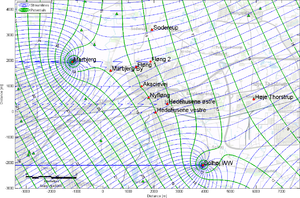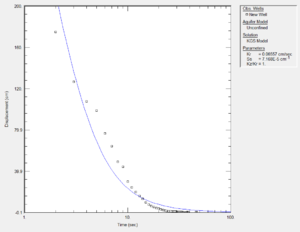Difference between revisions of "Modeling tools"
m |
m |
||
| Line 1: | Line 1: | ||
| + | {| class="side1" | ||
| + | !Highlights | ||
| + | |- | ||
| + | | | ||
| + | try it out | ||
| + | |} | ||
| + | |||
| + | {| class="body1" | ||
| + | | | ||
== Modeling tools == | == Modeling tools == | ||
| Line 102: | Line 111: | ||
{{Return}} | {{Return}} | ||
| + | |} | ||
[[Category:Modeling]] | [[Category:Modeling]] | ||
Revision as of 10:07, 9 February 2017
| Highlights |
|---|
|
try it out |
ContentsModeling toolsThe following list shows some selected modeling tools that can be used for the simulation of fracture flow and transport. Their capabilities with respect to modeling flow and transport in fractured media are compared in the chapter Comparison of capabilities . COMSOL MultiphysicsCOMSOL Multiphysics® is a comprehensive and flexible modeling suite that can be used to simulate various kinds of physics. It is well suited for computing flow and transport in limestone aquifers. It provides predefined physics-based interfaces (e.g. a module for subsurface flow) and allows equation-based modeling, where arbitrary partial differential equations can be solved. Different physics can be coupled, so a flow model can be coupled with a transport model. The toolbox provides tools for geometry and mesh generation, a user interface for the simulation setup, several different solvers, and visualization and post-processing tools. Discretization methods etc. For the modeling of flow in fractures, there is a predefined physics interface available. However, there is no fracture transport interface yet, but it is possible to manually include the fracture transport physics. The flow and transport equations can be implemented as partial differential equations and the fracture flow and transport can be added using a feature called "Weak contributions". Here is an instruction file which describes how to setup a 2-dimensional flow and transport model including fracture flow and transport in COMSOL Multiphysics. FEFlowFEFlow is a simulator focused on groundwater flow and transport of contaminants, groundwater age and heat in porous media. It comprises mesh generators, solvers and post-processing tools for visualization and result evaluation. It facilitates the computation of porous medium flow and transport in 2D and 3D aquifers, which can be confined, semi-confined or unconfined. Unsaturated flow can also be modeled with an approach that uses the Richards model. (Hydro-)geologic data can be easily imported and discrete fractures can be included. HydrogeospherePetrelFRACGEN and NFFLOWFRACMANUseful helpersBesides the comprehensive models, there are several small tools available that can be helpful when dealing with contaminant transport in limestone aquifers. Some of them will be described in the following. Leaching concentration profiles from a contaminant source (spreadsheet tool)DTU V1D is a simple spreadsheet tool for the calculation of the leaching concentration profiles from a contaminant source through a low-conductive porous medium to an underlying aquifer, based on the analytical solution presented in Chambon (2011). The tool and the manual can be downloaded on the following homepage: The analytical solution is described in the paper by Chambon, Binning, Jørgensen and Bjerg, J. Cont. Hydrology 124, 2011, p. 82-98. [1]. Tool by Henrik AktorCapture zone delineation of extraction wells (Matlab model)Contaminated sites can often pose a threat to water suppliers. Christ and Goltz have developed a semi-analytical algorithm that allows estimating the capture zones of extraction wells. A simple Matlab model was developed based on the algorithm from Christ and Goltz, which requires only a few parameters to estimate the capture zone of production wells with a given groundwater flow. This can be very useful to get a quick estimate, if a contaminant is likely to flow towards a drinking water well, for example. Required parametersFollowing parameters are required to set up and run the model:
The model computes streamlines and isopotential lines for the given parameters. When a background map of the study area is specified, the streamlines and isopotential lines are directly plotted on the map, as shown in the example below. The semi-analytical solution is described in the paper by Christ and Goltz, J. Hydrology, 2002, p. 224-244. [2]. A Matlab example file can be seen here: The example including the background map shown above can be downloaded as zipfile here: Hydraulic parameters from aquifer tests using AqtesolvAqtesolv is an easy-to-use tool for the design and interpretation of aquifer tests like pumping tests and slug tests. It provides a variety of conventional solution methods for aquifer tests in confined, leaky and unconfined aquifers and several advanced methods, e.g. for fractured aquifers or oscillating water tables. A comprehensive description of the capabilities and a free demo version is available on the software's webpage. The software tool contains a comprehensive help menu that provides explanations of the different solution methods and the required parameters. Geologic modeling with GeoScene3DGeoScene3D is a tool to import and work with borehole data to create a geologic model. It is possible to directly import data from the Danish borehole database Jupiter and to interpolate borehole data, for example to obtain the surface of the top of the limestone. |

